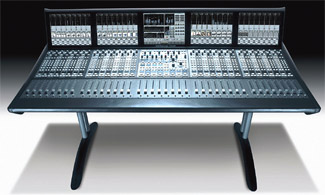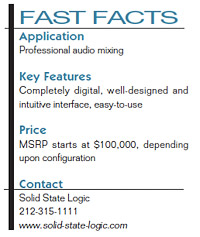Solid State Logic C10 HD Digital Console

The Solid State Logic C10 digital audio console
Solid State Logic is well known as a maker of robust and innovative digital audio consoles for the broadcast and film industry, largely based on the performance of high-end systems such as the C100 HD production console. However, now that the entire broadcast industry has gone digital, there is a need to upgrade systems among all stations, many of which have more limited budgets. SSL developed the C10 HD to fill this particular need, offering the same advanced technology in a console scaled down in physical size and price.
FEATURES
The Solid State Logic C10 HD broadcast console is fully digital, incorporating SSL's Blackrock DSP engine within the console control surface. Surface configurations are available as 24 or 32 channel strips and eight main group faders. It's also completely silent due to its convection-cooled design.
The C10 HD is physically smaller than the company's C100 HD, so that it can economize space in smaller facilities. The 24+8 configuration is 48-inches wide by 30.2-inches deep. The 32+8 configuration is only 11 inches wider.
However, the main attraction of this console is the carefully designed graphic interface and a list of innovative features that greatly simplify the job of providing high quality broadcast audio.
The SSL C10 has an impressive visual display, featuring five TFT screens that have wide viewing angles and an image that is easy on the eyes. The center screen includes touchscreen capability and can be reconfigured for a variety of tasks.
The console provides full 5.1 surround audio capability and a touchscreen that allows the user to move sound sources to any part of the surround space and see exactly where they are placed in the sound image. The settings can be saved and recalled when desired.
One problem facing local broadcasters today is that much of their audio library and locally produced commercial content is still in basic stereo. Viewers with sur-round sound systems complain that the audio collapses when local content is aired. To overcome this, the SSL C10 HD console has the ability to upmix stereo con-tent to 5.1 surround audio. This is done with an ingenious algorithm that separates sound elements and allows them to be placed in the surround environment. The result is a convincing 5.1 image upmixed from a stereo source. The upmix settings for a particular show can be stored. Stations can even record 5.1 upmixes of their entire audio library, thus avoiding the high cost of re-recording show intros, segues and other vital audio sources for the inevitable transition to HD and 5.1 audio.
Another important feature conquers the ever-present challenge of trying to maintain an optimum sound mix with microphones for numerous people appearing on separate channels. The audio operator needs to turn off channels when someone is not speaking to reduce unwanted sound, and is often late to bring the level up when a person speaks. Leaving all mic channels up can result in echoes and undesirable sound quality. The SSL C10 HD handles this with a "Dialogue Automix" op-tion. Automix keeps channels activated only when a person is speaking and manages the overall gain of the system. The result is very clean audio, and the viewer will never experience those awkward moments when a person begins to speak before the fader is turned up.
For mixing audio from remote feeds, the SSL C10 HD also includes significant advancements. One is the ease by which mix-minus feeds can be created for report-ers in the field. By simply pressing one button, the mixer creates a separate bus with a unique sound mix that can be sent to the reporter, omitting the reporter's voice and other designated sounds. One can create multiple cue feeds almost instantly.
One of the most striking features of the SSL C10 HD is its overall graphic sensibility. Putting as much visual information as possible into visual form increases effi-ciency and helps avoid errors. For example, each track has a full color display that can show any image that helps to identify the channel. This can be particularly useful in a talk show where numerous people come and go and the audio mixer may not know the name of every guest. A photo of each person can be placed above their channel making it much easier to identify and track the talent. Other tracks can be loaded with images identifying remote locations, or VTR and other sources. The desired images can be downloaded via TCP/IP connections or called up from the SSL C10 HD console's internal hard drive.
The SSL C10 HD has full memory capability, allowing users to create detailed show presets. Channel images, and all other settings are stored and can be called up instantaneously to create a board setting designed for any program in use.
The console also has advanced I/O features. It can provide up to eight built-in MADI-over-fiber audio connections for interfacing with a range of peripheral I/O options. Standard optional I/O units include Alpha-Link Live, with 24 balanced analog lines, and Alpha-Link 8-RMP, with eight analog mic preamps. The more ad-vanced I/O units provide up to 254 channels of local I/O and customizable units. By using fiber optic connections, the C10 eliminates analog lines and associated signal degradation.
Finally, the SSL C10 HD is designed to allow users with different levels of expertise to use the console based on a password entry. The administrator has full con-trol of the entire setup. Standard access allows an experienced user to configure the settings. The "Preset" access level allows users, such as freelancers, to recall show and channel presets, and the "locked" mode allows the console to be left in tamper-proof mode.
IN USE
The SSL C10 HD is a bit large to ship for review purposes, so I made a visit to a local television station in Boston for some hands-on experience with a demo unit. Solid State Logic's vice president of broadcast sales, Steve Zaretsky, helped to walk me through the features.
We monitored a pre-recorded video feed from a basketball game that included 16 tracks of audio—an announcer and numerous microphones placed around the stadium for 5.1 surround sound. This provided a good display of the 5.1 touch pan feature. This is a very simple visual device for placing sound sources. There is an LCD touchscreen in the console that allows you to pick any sound source and simply move it with your finger to any point in the surround sound space. For exam-ple, the announcer's voice could be moved from the front, middle, behind or anywhere simply by moving a point on the LCD graph. It is entirely visual and intuitive. This is in keeping with the overall design of the system that emphasizes visual control. With the push of a button, the 5.1 mix can also be changed to stereo. Each input fader automatically conforms to its source material. If a sound source is mono, stereo or 5.1, the fader conforms and displays the appropriate status.
In another demonstrated situation, we ran audio from a pre-recorded news show. In this case, assigning images to the channels (a head shot of each member of the show) made it very easy to keep track of the talent speaking on each channel. This could be particularly valuable when freelance audio mixers mix a show. Someone new to the show can view the images of the talent and quickly manage the mix without having to associate names with audio inputs. Reassigning an image to a channel by choosing from a stored library on the network proved to be quickly and easily accomplished.
Another advantage of the SSL C10 HD is its ability to instantly conform to the presets for a specific show. With the push of a button, one can call up all of the chan-nel settings for EQ, sound level and any other adjustments needed for a particular show. Then another push of the button instantly reconfigures the console for a talk show, sportscast or whatever may be next.
Each channel features four-band EQ, a compressor, limiter, insert and delay. The C10 provides 64 channels of delay, with up to 5.4 seconds per channel. This is particularly important nowadays in connection with digital broadcasting. A typical problem is that audio precedes video because of the longer time video takes to be processed. The C10 provides delay compensation with the simple turn of a knob.

The Solid State Logic C10 digital audio console The Dialogue Automix was amazingly accurate in shutting down channels not currently in use by talent and activating them just before a person speaks. In our test, the mixer activated and deactivated channels, following those speaking or going silent without error. There was never any missed audio, and the resulting mix was devoid of any unwanted background noise.
The mix-minus feature is very easy to use. You simply choose the channels you want to remove from the mix and press a single button to create a bus mix with those settings. The 5.1 up-mix feature particularly impressed me because it creates a very convincing 5.1 sound image from a standard stereo source. I was actually unable to notice the difference between music that was created in 5.1 from that which was up-mixed from stereo. I started mentally calculating the cost difference of converting a station's sound library from stereo to 5.1 in this fashion, as opposed to re-recording everything, and felt that the SSL C10 HD may almost pay for itself from just this one feature.
SUMMARY
The SSL C10 HD is an exceedingly well-designed audio console that's perfect for a television station that needs to upgrade to digital performance but lacks a large budget. The unit offers the capability and many of the advanced features of its C100 HD brother, but in a more compact size and price.
Overall, though, what I found most impressive about the SSL C10 is its elegant and intelligent graphic design. The board is so well planned out visu-ally, that you can virtually execute a sound mix without actually hearing it. While no one would advocate this, it attests to the attention paid to visual cues at all levels that tell you everything you need to know in a visually pleasing way. The console strikes a nice balance between physical buttons maintaining a constant presence and programmable controls that can be customized at will. My final thought after seeing the SSL C10 HD in action was that every broadcast facility that sees this new console is going to want one.
Geoff Poister, Ph.D., is a member of the Film and Television faculty at Boston University and a regular contributor to TV Technology.
Get the TV Tech Newsletter
The professional video industry's #1 source for news, trends and product and tech information. Sign up below.
